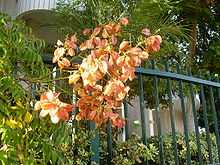Koelreuteria bipinnata
| Koelreuteria bipinnata | |
|---|---|
 | |
| Scientific classification | |
| Kingdom: | Plantae |
| (unranked): | Angiosperms |
| (unranked): | Eudicots |
| (unranked): | Rosids |
| Order: | Sapindales |
| Family: | Sapindaceae |
| Genus: | Koelreuteria |
| Species: | K. bipinnata |
| Binomial name | |
| Koelreuteria bipinnata Laxm. | |
Koelreuteria bipinnata, also known as (Chinese flame tree, Chinese golden rain tree, Bougainvillea golden-rain tree") is a species of Koelreuteria native to Asia, particularly to China. It is a small to medium-sized deciduous tree growing between 10–20 meters tall. They are also one of the few trees that bloom in the summer. They can live from 50 to 150 years.

Description
The leaves are alternate, bipinnately compound leaves; with a ovate shape and a pinnate venation, they have a green color usually and turns yellow in fall, measuring between 5–10 cm long.
The flowers are small and yellow with a touch of red at the base, with four petals, produced in large branched panicles that are 20–50 cm long. They are very showy and have a pleasant fragrance. They flower in the summer from July to August; they are also hermaphrodite which mean they have both male and female organs.
The fruit is a three-lobed inflated papery capsule that is 3–6 cm long, containing several hard nut-like seeds that are 5–10 mm diameter with a pink color.
The bark is thin and brown, bends down a little as the tree grows, it might break due to poor collar formation, pruning is required to develop a strong structure, and also for the pedestrians and vehicles clearance if necessary. The tree is characterized as a weak wooded tree.
History & Location
The tree is Native to China; its discovery is credited to Pierre d'Incarville, a Jesuit missionary; who sent first seed from China to Russia in 1747. It was classified by Russian botanist Erich Laxmann who named it after Joseph Koelreuter, a contemporary and a professor of natural history at Karlsruhe. It was later grown in Europe by 1753 and reached America in 1811. Now, they grow mostly in China, Korea, Japan, Europe, New Zealand, Australia, Israel and some parts of the United States (Eastern and Western coasts, and Southern States).

How to grow them
They grow in nutritionally poor soil including: clay, sand, well drained, alkaline, loam; they require full sun but not a lot of watering, with a moderate aerosol salt tolerance. They tolerate wind, air pollution, salt, heat, and drought. They grow moderately and are sometimes fast growers. They produce seeds that are blown away and get germinated and this might result in the growing of more trees next to the original one.
Pests and Diseases
The Koelreuteria bipinnata have little to no pests or disease threatening them. The bark of the tree might get affected from a canker that hits some of its areas. Also, coral pink bodies may develop on the diseased bark that will require pulling off the infected branches to keep the tree in good health.

Uses
Koelreuteria bipinnata are commonly used as focal points in landscape design in regions where they thrive; they are often used as street, highways, parking lots, shade, woodland garden or specimen trees. The seeds are used in beads in necklaces and the flowers are used in getting yellow dye. They are also used in treatments of conjunctivitis and epiphora.
References
| Wikimedia Commons has media related to Koelreuteria bipinnata. |
| Wikispecies has information related to: Koelreuteria bipinnata |
- Koelreuteria bipinnata info
- Koelreuteria bipinnata Chinese Flame-Tree
- Chinese flame tree
- Koelreuteria bipinnata General Notes